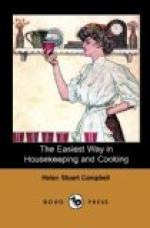* * * * *
MEATS.
The qualities and characteristics of meats have already been spoken of in Part I., and it is necessary here to give only a few simple rules for marketing.
The best BEEF is of a clear red color, slightly marbled with fat, and the fat itself of a clear white. Where the beef is dark red or bluish, and the fat yellow, it is too old, or too poorly fed, to be good. The sirloin and ribs, especially the sixth, seventh, and eighth, make the best roasting-pieces. The ribs can be removed and used for stock, and the beef rolled or skewered firmly, making a piece very easily carved, and almost as presentable the second day as the first. For steaks sirloin is nearly as good, and much more economical, than porter-house, which gives only a small eatable portion, the remainder being only fit for the stock-pot. If the beef be very young and tender, steaks from the round may be used; but these are usually best stewed. Other pieces and modes of cooking are given under their respective heads.
MUTTON should be a light, clear red, and the fat very white and firm. It is always improved by keeping, and in cold weather can be hung for a month, if carefully watched to see that it has not become tainted. Treated in this way, well-fed mutton is equal to venison. If the fat is deep yellow, and the lean dark red, the animal is too old; and no keeping will make it really good eating. Four years is considered the best age for prime mutton.
VEAL also must have clear white fat, and should be fine in grain. If the kidney is covered with firm white fat, it indicates health, and the meat is good; if yellow, it is unwholesome, and should not be eaten. The loin and fillet are used in roasting, and are the choice pieces, the breast coming next, and the neck and ribs being good for stewing and fricassees.
PORK should have fine, white fat, and the meat should be white and smooth. Only country-fed pork should ever be eaten, the pig even then being liable to diseases unknown to other animals, and the meat, even when carefully fed, being at all times less digestible than any sort. Bacon, carefully cured and smoked, is considered its most wholesome form.
POULTRY come last. The best Turkeys have black legs; and, if young, the toes and bill are soft and pliable. The combs of fowls should be bright colored, and the legs smooth.
Geese, if young and fine, are plump in the breast, have white soft fat, and yellow feet.
Ducks are chosen by the same rule as geese, and are firm and thick on the breast.
Pigeons should be fresh, the breast plump, and the feet elastic. Only experience can make one familiar with other signs; and a good butcher can usually be trusted to tide one over the season of inexperience, though the sooner it ends the better for all parties concerned.




